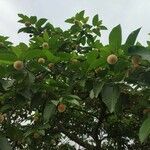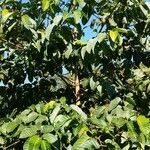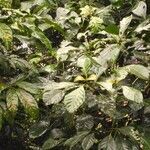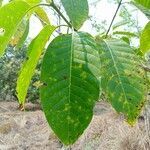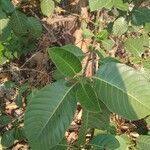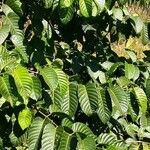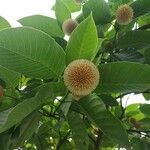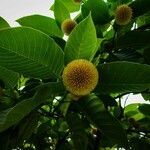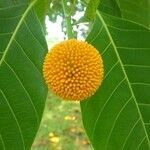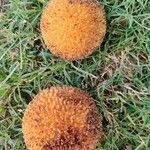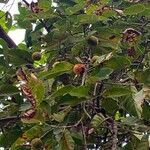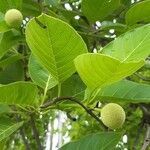Trees, deciduous, to 30 m tall; trunk with small buttresses; bark thin, grayish brown, fissured and scabrous when old; branches horizontally spreading, flattened becoming subterete, glabrescent. Petiole 20-35 mm, glabrous; leaf blade drying thinly leathery, elliptic or oblong-elliptic, on juvenile growth 50-60 × 15-30 cm, on adult growth 15-25 × 7-12 cm, adaxially shiny and glabrous, abaxially glabrous to densely puberulent, base shallowly cordate on juvenile growth, rounded or truncate on adult growth, apex acute; secondary veins 8-12 pairs, apparently without domatia; stipules lanceolate, 12-20 mm, acute. Inflorescences with peduncle 2-4 cm, rather stout; flowering heads 35-45 mm across calyces, 40-60 mm across corollas. Calyx puberulent to pilosulous; ovary portion ellipsoid to obovoid, ca. 1.5 mm; limb 3-4 mm, partially to deeply lobed; lobes oblong to spatulate, obtuse to rounded. Corolla yellowish white, funnelform, outside glabrous; tube ca. 10 mm; lobes lanceolate, ca. 2.5 mm. Fruiting heads yellowish green, 30-40 mm in diam., with peduncles markedly thickened. Fruit cylindrical to ellipsoid or obovoid, 2-2.5 × ca. 1 mm, glabrous; seeds 3-angled, 0.5-0.7 mm. Fl. and fr. Jun-Nov.
More
A large tree up to 15 to 30 m high and 40 to 60 cm across the trunk. It spreads 5-10 m wide. It has stiff spreading branches. It loses its leaves during the year. It can have buttresses. The branches are stiff and spread outwards. The bark is thin and slightly rough and grey to light brown. It is flaky. The bark of old trees is dark, rough and cracked. The leaves are simple, opposite, leather like, dark green above and pale green beneath. They are broad being 20 to 25 cm long and 11 to 15 cm wide. They droop downwards. Young leaves are much larger. The base is rounded and the tip tapering and with a point. The leaf edges are entire and the leaf stalk is robust and 4 to 5 cm long. The leaf like appendage at the base of the leaf stem is slightly flattened and tapering and remains on the twigs. The flowers have both both sexes together and they are numerous. They occur in yellowish round heads 3-4 cm across. These occur singly at the ends of branches. The fruit is made up of the ovaries of several flowers joined together. This multiple fruit is fleshy, round and about 3 to 5 cm across. They are yellow when ripe.
A tropical plant. It suits tropical and subtropical places. It grows in rainforests and along streams. It needs a warm sunny position and a well-drained soil. In Nepal it grows up to 1000 m altitude. They occur in the Philippines in Mindanao, particularly in the provinces of Bukidnon and Cotabato. They are also growing in Makiling Forest, Laguna. In Yunnan.
More
An early-succession species, it grows best on deep, moist, alluvial sites, often in secondary forests along riverbanks and in the transitional zone between swampy, permanently flooded and periodically flooded areas.
